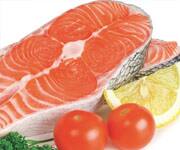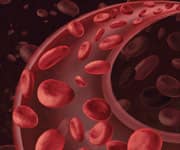Life Extension Magazine®
Omega-3s May Reduce Risk Of Lou Gehrig’s Disease | |
An article published in the Journal of the American Medical Association Neurology reports that those who consumed high levels of omega-3 fatty acids had a dramatically reduced risk of developing amyotrophic lateral sclerosis (ALS, or Lou Gehrig’s disease) in a meta-analysis of five large studies.* The researchers analyzed the diets of over a million participants for a period of nine to 24 years. During this time, 995 individuals were detected with ALS. Omega-3 fatty acids have been shown to reduce inflammation and oxidative stress on cells and both of those processes damage nerve tissue and have been linked with ALS. In the study, “individuals with higher dietary intakes of total omega-3 fatty acids had a reduced risk for ALS,” said lead researcher Kathryn Fitzgerald, of the Harvard School of Public Health in Boston. Those in the top 20% in terms of their omega-3 fatty acid consumption reduced their risk of developing ALS by one-third, compared to those in the bottom 20%. Editor’s Note: “We also found that higher dietary intake of alpha-linolenic acid, a type of omega-3 fatty acid found in vegetable oils and nuts, is associated with lower ALS risk,” Kathryn Fitzgerald added. |
|
| Reference | |
* JAMA Neurology 2014 Jul 14. |
|
Vitamin D Boosts Survival Rates Of Colon Cancer Patients | |
|
The results of a study reported in the Journal of Clinical Oncology found that colon cancer patients with the highest levels of vitamin D in their blood had half the risk of dying when compared with patients with the lowest levels.* Researchers at the Medical Research Council Human Genetics Unit at the University of Edinburgh studied almost 1,600 patients who had surgery for colorectal cancer. The study is the first to link long-term survival predictions of colon cancer patients after diagnosis with total blood levels of vitamin D. Vitamin D is known to boost calcium absorption and bone growth. Previous studies have suggested a correlation between low vitamin D levels and an increased risk of many diseases including osteoporosis, cancer, and cardiovascular diseases. The researchers, led by Professor Malcolm Dunlop of the University of Edinburgh and Western General Hospital, UK, tested blood samples from almost 1,600 patients after surgery for colon cancer. They found the greatest benefit of vitamin D in patients with stage II cancers, when the tumor is large, but hasn’t yet spread. Three-quarters of the patients with the highest vitamin D levels were still alive after five years, compared with less than two-thirds of those with the lowest levels, they found. Editor’s Note: A 2011 study published in the Anticancer Research journal by researchers at the Department of Family and Preventive Medicine, University of California, San Diego, found that breast cancer patients with high blood levels of vitamin D are twice as likely to survive the disease as women with low levels. |
|
| Reference | |
* J Clin Oncol 2014 Jul 7. |
Increased Fiber Intake Linked To Lower Risk Of Premature Mortality In Heart Attack Survivors |
An article published on April 29, 2014, in the British Medical Journal reveals an increase in the number of years lived by heart attack survivors who consumed a greater amount of fiber.* Shanshan Li and colleagues of Harvard School of Public Health, Boston, utilized data from 1,840 men enrolled in the Health Professional Follow-Up Study and 2,258 women from the Nurses’ Health Study who had survived an initial adverse heart event of myocardial infarction (MI) during the studies’ follow-up periods. Dietary questionnaires, completed every four years, provided information on fiber intake before and after MI. In a pooled analysis of all subjects, those whose post-MI intake of fiber was among the top one-fifth of participants had a 25% lower risk of dying from any cause in comparison with those whose intake was among the lowest fifth over a nine-year average follow-up. Editor’s Note: When fiber was analyzed by source, cereal fiber emerged as significantly protective. |
|
| Reference | |
* BMJ. 2014 Apr 29. |
|
Low Bone Mineral Density Linked To Heart Failure | |
An analysis published in the Journal of the American College of Cardiology suggests that lower bone mineral density may lead to a higher risk of
developing heart failure.* “Our findings give support for cardiac assessment in people with reduced bone mineral density and warrant further exploration of underlying biological mechanisms,” said lead author, Dr. Roman Pfister of the Heart Center of the University of Cologne, Germany. “This is of major clinical interest because osteoporosis and low bone density are common, particularly in the elderly, affecting approximately 52 million persons in the United States, and screening for osteoporosis is recommended for all women 65 years of age or older and all younger women with a similar disease risk.” Editor’s Note: Vitamin K2 may also decrease osteoporosis risk and thereby lower heart failure risk. Vitamin K2 helps promote strong bones by binding calcium and other minerals to bone. A two-year Japanese study published in the Journal of Bone and Mineral Research in 2000 found that patients supplemented with vitamin K2 (MK-4) had 52% fewer incidences of vertebral fractures, compared with patients who did not receive this nutrient. | |
| Reference | |
* J Am Coll Cardiol . 2014 Jul 2. | |
Omega-3 Supplements Ease Osteoarthritis Pain In Mice | |
A study by Duke University researchers published in the Annals of the Rheumatic Diseases found that mice fed omega-3 fatty acid supplements had healthier joints than those fed diets high in saturated fats and omega-6 fatty acids, suggesting that certain dietary fats, and not simply body weight, can lead to osteoarthritis.* Four-week-old mice were fed a low-fat diet or one of three high-fat diets: a diet high in saturated fat, a diet high in omega-6 fatty acids, or a diet high in omega-6 fatty acids plus a supplement of omega-3 fatty acids. At 16 weeks, the mice had surgery to induce osteoarthritis of the knee. The animals that ate an unhealthy high-fat diet developed severe arthritis and joint inflammation compared to mice fed the regular diet or the high-fat diet supplemented with omega-3 fatty acids. “Our results suggest that dietary factors play a more significant role than mechanical factors in the link between obesity and osteoarthritis,” said Farshid Guilak, senior study author. Editor’s Note: The researchers also tested the mice for how quickly small ear punch wounds healed. The wounds healed much more quickly in the mice given omega-3 fatty acids than they did in the mice that did not receive the supplement. | |
| Reference | |
* Ann Rheum Dis. 2014 Jul 10. | |
Lycopene Supplementation Aids Blood Vessel Function In Heart Disease Patients | |
On June 9, 2014, PLOS One reported a benefit for lycopene in improving endothelial function in cardiovascular disease patients.* In a double-blind trial, Joseph Cheriyan and colleagues randomized 36 cardiovascular disease patients treated with statin drugs and an equal number of healthy control subjects to receive either 7 mg oral lycopene or a placebo daily for two months. Forearm blood flow assessments of endothelium dependent and independent vasodilation, as well as basal nitric oxide synthase activity, were conducted before and after treatment. In the cardiovascular disease group, endothelial-dependent vasodilation improved by 53% in those who received lycopene compared to those who received placebo. Although it averaged 30% lower in cardiovascular disease patients in comparison with healthy volunteers at the beginning of the study, by the end of the treatment period the endothelial-dependent vasodilation of participants with cardiovascular disease who received lycopene was comparable to that of the healthy subjects at the study’s onset. Editor’s Note: Lycopene is an antioxidant that is found in tomatoes, watermelon, and other red fruits, in addition to being available as an over-the-counter supplement. | |
| Reference | |
* PLOS One. 2014 Jun 9. | |
Low-Dose Aspirin Associated With Pancreatic Cancer Risk Reduction | |
A study described in Cancer Epidemiology, Biomarkers & Prevention uncovered an association between long-term use of low-dose aspirin and a decreased risk of pancreatic cancer.* Utilizing data from 362 men and women with pancreatic cancer matched to 690 control subjects enrolled in the Connecticut Pancreas Cancer Case-Control Study, researchers at Yale University determined that regular use of aspirin was associated with a 48% lower risk of cancer of the pancreas in comparison with non use. Each increasing year of regular aspirin use was associated with a 2% lower risk of the disease and each year of low-dose use with a 6% lower risk. “There seems to be enough evidence that people who are considering aspirin use to reduce the risk for cardiovascular disease can feel positive that their use might also lower their risk for pancreatic cancer, and quite certainly wouldn’t raise it,” researcher Harvey A. Risch commented. Editor’s Note: “Because about one in 60 adults will get pancreatic cancer and the five-year survival rate is less than 5%, it is crucial to find ways to prevent this disease,” Dr. Risch observed.” | |
| Reference | |
* Cancer Epidemiol Biomarkers Prev. 2014 Jun 26. | |
Severe Calorie Restriction Suspends Worm Development | |
The journal PLOS Genetics published the discovery of researchers from Duke University about an arrest in the development of the roundworm C. elegans when its calories were severely restricted.* Although the semi-starved worm continued to forage, its cells and organs entered a quiescent state during which development paused. Upon regaining access to food, development was resumed, yet life span can be twice as long as that of normal worms. Acting on previous findings in C. elegans, David R. Sherwood and colleagues discovered that severely restricting food during the final two stages of larval development resulted in pauses at specific stages, but not between those stages. The pauses appear to occur at checkpoints that allow the organism to assess its viability before proceeding to the next stage. If the worm has failed to accumulate sufficient nutrients, development was arrested until the need was met. Editor’s Note: “It is possible that low-nutrient diets set off the same pathways in us to put our cells in a quiescent state,” speculated Dr. Sherwood, who is an associate professor of biology at Duke. “The trick is to find a way to pharmacologically manipulate this process so that we can get the anti-aging benefits without the pain of diet restriction.” | |
| Reference | |
* PLOS Genetics. 2014 June 19. | |
Cognitive Function Improved With Vitamin B Supplementation In Those With Elevated Homocysteine | |
On June 18, 2014, the journal Nutritional Neuroscience reported the findings of a clinical trial of middle-aged and older men and women who experienced a reduction in homocysteine and better cognition in association with B vitamin supplementation.* The trial included 104 subjects aged 55 to 94 with hyperhomocysteinemia. Participants received 800 micrograms folate, 10 mg vitamin B6, and 25 micrograms vitamin B12, or a placebo daily for 14 weeks. Cognitive aptitude tests and serum analysis of total homocysteine, folate, vitamin B6, and vitamin B12 were conducted before and after treatment. Not surprisingly, B vitamin levels improved among those who were supplemented with them. Homocysteine slightly increased in the control group while declining by an average of 3.3 micromoles per liter in those that received B vitamins. Cognitive function significantly improved among those in the vitamin group. Editor’s Note: “We recommend that all elderly should take B vitamin supplements regularly if the blood test results indicate that the homocysteine concentrations are abnormal,” authors Daomei Cheng and colleagues concluded. | |
| Reference | |
* Nutr Neurosci. 2014 Jun 18. |
|
Cinnamon Could Stop Parkinson’s In Its Tracks | |
An article appearing in the Journal of Neuroimmune Pharmacology indicates that cinnamon could one day be used by Parkinson’s disease patients to prevent the disease from progressing.* Saurabh Khasnavis and Kalipada Pahan, PhD, of Rush University Medical Center, studied the effects of the spice in a mouse model of Parkinson’s disease. They found that when cinnamon is metabolized into sodium benzoate in the blood and brain, the loss of beneficial proteins known as Parkin and DJ-1 was halted, while neurons that produce dopamine, a neurotransmitter that is reduced in Parkinson’s, were protected. Motor function, which can be significantly impaired by the disease, was improved in animals that received cinnamon. “Understanding how the disease works is important to developing effective drugs that protect the brain and stop the progression of Parkinson’s disease,” Dr. Pahan remarked. “It is known that some important proteins like Parkin and DJ-1 decrease in the brain of Parkinson’s disease patients.” Editor’s Note: “If these results are replicated in Parkinson’s disease patients, it would be a remarkable advance in the treatment of this devastating neurodegenerative disease,” Dr. Pahan added. | |
| Reference | |
|
* J Neuroimmune Pharmacol. 2014 Jun 20. | |
Calcium+Collagen Combo = Better Bone Benefits | |
|
The Experimental Biology 2014 Annual Scientific Meeting was the site of a presentation of research that suggests a superior effect for a combination of calcium, collagen, and vitamin D in preventing a decline in bone mineral density among older women.* Bahram H. Arjmandi, PhD, and colleagues from the Department of Nutrition, Food, and Exercise Sciences at Florida State University, evaluated the long-term effects of a calcium-collagen chelate dietary supplement known as KoACT® in 39 postmenopausal women with osteopenia (bone mineral density that is lower than normal but not as low as in osteoporosis). Participants received an amount of KoACT® that contained 500 mg elemental calcium and 200 IU vitamin D3 per day, or a control supplement that provided equal amounts of vitamin D and calcium for one year. Total body, lumbar spine, and hipbone mineral density were measured, and markers of bone turnover were assessed at the beginning at the trial, and at six and 12 months. At the study’s conclusion, women receiving KoACT® had significantly less bone mineral density loss than the control subjects. Editor’s Note: Tartrate-resistant acid phosphatase (a marker of bone resorption; increased levels of this enzyme indicate increased bone loss) and sclerostin (a protein that has anti-anabolic effects on bone formation) were lower and the ratio of bone specific alkaline phosphatase (a marker of bone formation) to tartrate-resistant alkaline phosphatase was higher after six months in the KoACT® group, while the control group experienced no change. | |
| Reference | |
* Experimental Biology 2014 Annual Scientific Meeting. 2014 Apr. |










